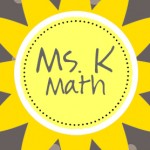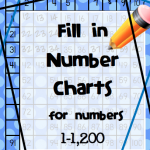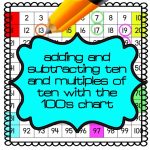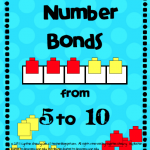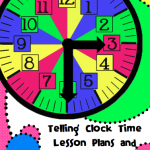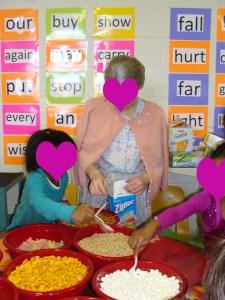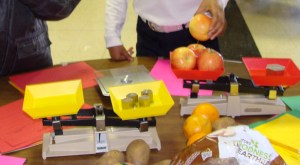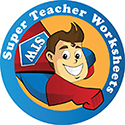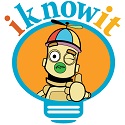Use This Simple Idea to Help Students Understand Fractions of an Inch
Because rulers have so many small lines, they are difficult for students to understand and differentiate. Because of this struggle, I took a flat ruler and placed it on the copy machine and blew it up until an inch section was about as large as the page like below.
Then I cut off the centimeter section and the marks after the one inch mark.
Because linear measurement is more difficult for students to conceptualize, I relate it to parts of a whole by using this enlarged ruler. Now that I have trimmed all of the sections off, students can see it as 1 WHOLE rectangular section as opposed to the daunting linear ruler. I have students fold the ruler section into half along the half inch line. When we study parts of a whole, we fold colored paper in half. This make the ruler like parts of a whole instead of a linear model, so the ruler marks are easier for students to understand.
Next, students label the half point on the ruler where the paper folded.
Then students fold the halves into half to make fourths and label the fourths. After labeling fourths, students begin to see equivalent fractions.
You could fold the fourths an additional time to make eighths also, but elementary students aren’t required to know eighths yet.
An additional fold would make sixteenths, but this is not really needed since all of the marks denote sixteenths. Now you and your students can pull this ruler out anytime you need to refer to the fractional measurements. The only thing to beware of is that students recognize this fractional pattern repeats for every inch. You will have to repeat the pattern for each number for students to recognize this. Another error that can occur is that students leave the whole number off of their measurement and only think that the fractional marks stand for fractions alone. Measuring to fractional inches greater than 1 and writing fractions greater than 1 need to be modeled. I hope this tidbit helps you and your students!
Edited 1/25/14: I just found this great free ruler picture that would be great to use for the above activity. You can see it here.
Heads Up! Linear Measurement Misconception!
While working with 5th graders today, I was reminded about the misconceptions they have when measuring with a ruler. Normally students are asked to measure to the nearest half or fourth of an inch. First of all, what does nearest really mean? We assume that 10 and 11 year old children know what nearest means…but do they? Our number one mistake as educators–especially new educators is that we assume students know the meaning of things they often do not…only as a reflective experienced teacher do we figure this out. (had to take that rabbit trail!) Back to measurement–once students are taught that nearest means closest we think we are in the clear, but, NOPE, we still have another problem. When you as the teacher say, “measure to the nearest half.” Students think that the only halves are the numbers that have halves written in them. For example, students think that the answer has to be 1/2, 1 1/2, 2 1/2, 3 1/2 and so on. They fail to bring their fraction understanding of wholes being two halves with them. Students can understand that measuring to the nearest half could mean the measurement might be a whole number (which is made up of halves) when they compare a linear ruler to wholes of a fraction like 2/2. This same misconception occurs when students are asked to measure to the nearest 1/4. Students think you are literally asking them to measure to only the nearest one-fourth. Even if a measurement is 2 inches, students will say that the measurement is 2 1/4 because they hear the phrase literally.
In the example below, students who have misconceptions measuring to the nearest 1/4 will, for example, say that this marker measures to be 5 1/4 because they are looking for the number 1/4 instead of the nearest 1/4 increment. In actuality, the marker measures to be 5 1/2 in., and students will only understand that this is the same as 2/4 through work with equivalent fractions. Please excuse the insurance advertisement on the ruler :/. This was the only ruler I had available at the time.
I will be posting more soon about teaching linear measurement :). Come back soon!
How Can You Incorporate Literacy with Coordinate Grids?
I was ecstatic when my new books arrived! I had been wanting to order these books for a while, and finally discovered that I had some money in the budget! What is so great about these books is that they tell the story of how Rene’ Descartes invented the coordinate plane. The general story tells of how he was sick in bed staring at a fly on the ceiling and wanted to map its location. As the old adage goes, “necessity is the mother of invention”, so Descartes visualized the coordinate grid system on his ceiling to locate the fly. This is such a great story to help students conceptualize coordinate grids while tying social studies (maps), literacy, and math together in one lesson!
Drumroll please……..
And the Tea-cher time giveaway winner is…(long three second suspenseful pause) Kimberly Malone!
Congratulations Kimberly! You will be receiving a wonderful package of specialty teas in the mail soon.
Readers, if you have a chance, read her great comment about fractions basketball here.
Teaching 3 Dimensional Solids?
Check the trash first! Whenever teaching dimensional solids, I look around the school building for large boxes that may be thrown out. Especially in the teacher workroom, there are always bulletin board paper boxes, toner boxes etc. that are being thrown away. This is where I have found some of the best trash for treasure pieces for my 3D solids collection. When I have found one, I wrapped it in colored bulletin board paper with the name on each one to help students have a constant visual of prism pieces. At the time I teach solids, I also have the students bring in items they find at home that may be prisms, cubes, spheres, or other solids. They relish sharing their found items with the class. When they share them with the class, they must ask the students how many faces, edges, and vertices there are. Students get extra credit for bringing in solids. The best solid that I ever had a student bring in was an almost perfect triangular pyramid made out of rock! Below are pictured my recycled trash 3D solids.
TEA-cher Time Giveaway!!
I am SO excited to be hosting a giveaway compliments of TRADITIONAL MEDICINALS® teas. They have a wonderful array of teas which are healthy and delicious. My favorite flavor is peppermint. Pictured below is the product sample package that they will be sending the lucky winner. I was so surprised when I received this in the mail because the sample was so nicely packaged. There is a ceramic mug (made in the USA I might add) three boxes of teas, a tote bag, and a tea sampler with different types of teas arranged ever so neatly in a wooden box. The teas all come packaged with descriptions of their health benefits.
I will be choosing one winner at random who comments below on the following prompt. Only U.S. residents may apply. The contest will be open until next Saturday at 11:59 p.m. CST.
Since spring is approaching, comment below about your favorite most creative math lesson or activity for spring. If you don’t do anything special for the season of spring, just tell us about your favorite math lesson.
How Can You Reach Parents During Family Night?
When looking for items to place at a table during family night for parents, I stumbled across some great info already made on a website. I took this info, and copied and pasted it into Microsoft Word with some cute fonts and borders. I would offer you my final product here, but I would be infringing on copyright. I will give you the links I used instead.
Ideas to Help Your Child Succeed and Enjoy Mathematics
Why Math Looks Different to Parents than When They Grew Up
And there is even a power point that you can play for parents–ready made!
See isn’t this great!
Do You Need an Idea for Family Math Night?
As promised, here are a few snapshots of our Family Math Event/100th Day of School Celebration!
Students built number bonds with Legos, and got to take a few Legos home!
Students built 10 groups of 10 to make 100 with different small food items. This was one of kids’ favorites since food was involved!
As you can see in the picture above, this is one of the staff members that dressed up like she was 100 years old. She said she got her whole outfit at Good Will for $4 with the exception of her wig from Party City.
Students played Race to 100 on the 100’s chart with dice. They rolled and added the number that they rolled each time on their 100’s chart.
Double dice subtraction is a game idea taken from the Georgia Department of Education resources.
How creative! This teacher made a multiplication/division edition of chutes and ladders complete with spinner. Kids loved this activity.
Kids flocked to this booth where they made chocolate chip cookie dough. Students mixed up the dough in a gallon baggie to prevent mess. The math was in the measuring cups fractions. They had to figure out how many small measuring cups to use in lieu of the larger cup sizes. For example, if the recipe calls for a cup and a half of flour, how many times will you have to fill a 1/4 measuring cup?
We can’t forget the Estimation Station! The closest guesser got to go home with the jar including candy! We gave away five jars.
One of my personal favorites…maybe because it was my idea ;), is the 100 scavenger hunt. Students had to find index cards hidden around the cafeteria. Each card had an equation, but only some of the equations equaled 100. If the equation made 100, students could then bring it to the scavenger hunt booth for a prize.
Students used different fruits and vegetables to equal up to a pound in this next picture after first estimating.
At the probability booth students used fractions to predict the chances of landing on a variety of spinners. Students got to take home their own spinners.
We also had a technology table where students got to play math games on our schools mini laptops.
Moe’s Southwest grill kindly donated tortilla chips for us to have nachos! And, the church next door to our school kindly donated lemonade! We also got plastic sacks donated to us from a nearby restaurant so that students had a bag in which to place all of their take home math activities.
The kids went home with smiles!
A Few of the Best 100 Days of School Dress Up Costumes!
The following are some of the best 100 days of school dress up that we had. We incorporated our Math Family Night with our Students’ 100th day of School Celebration. I sent this letter that I used last year to inform parents of the day’s dress up celebration. Again I used a rubric I adapted from Ms. Saoud’s blog at Primary Graffiti here.
Which costume do you like best?
Which child’s costume do you think won?
I’ll tell you at the end of the post! 🙂
My favorites are the “Name Your Own Star” –how clever…and the wrestlers belt–how creative! I also especially like the student in the school uniform with the notes safety pinned to her because it looks very kid done! Each note has a different word on it.
Here is my favorite staff dress up outfit. 
We also had a couple of staff members who dressed up like they were a hundred years old. They had walkers and all! One of our staff members had a sign on her front that said I am 100 years old. On her back she had a question that asked, “When was I born?” The kids had to bring her the answer written on a piece of paper.
I have a thing for puffballs, so I used 100 puffballs to make a scarf of sorts. It didn’t quite turn out like I had wanted. I used hot glue, so it was a bit stiff. I glued all the puffballs to a ribbon. Maybe if I was more of a seamstress it could have been a real scarf! Nevertheless the kids loved the scarf and wanted to touch the puffs. I gave the scarf away to one of the kids who asked me if he could have it at the end of the day.  I guess you get to see my totally cute new phone cover in the picture, too! What an added perk! 🙂
I guess you get to see my totally cute new phone cover in the picture, too! What an added perk! 🙂
To answer your question if you were wondering which child won from above, the first picture won of the little girl in the red shirt with all of the beads hanging down from safety pins.
